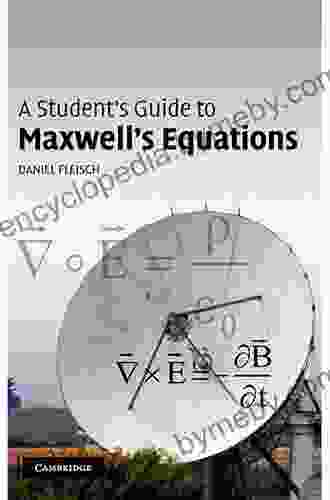The Student's Guide to Maxwell's Equations: Unlocking the Secrets of Electromagnetism

James Clerk Maxwell's equations are a set of four partial differential equations that describe the behavior of electric and magnetic fields. They are considered to be one of the most important and fundamental sets of equations in all of physics. Maxwell's equations have applications in a wide range of fields, including electromagnetism, optics, and electrical engineering.
This guide is intended to provide students with a comprehensive and accessible to Maxwell's equations. We will start by discussing the basic concepts of electromagnetism, and then we will gradually develop Maxwell's equations from first principles. Finally, we will explore some of the applications of Maxwell's equations in the real world.
4.8 out of 5
| Language | : | English |
| File size | : | 5035 KB |
| Screen Reader | : | Supported |
| Print length | : | 146 pages |
Basic Concepts of Electromagnetism
Electromagnetism is the branch of physics that deals with the interactions between electric and magnetic fields. Electric fields are produced by electric charges, and magnetic fields are produced by moving electric charges.
The basic unit of electric charge is the coulomb (C). The coulomb is a very large unit, so it is often convenient to use smaller units, such as the milliampere (mA) or the microampere (µA).
The basic unit of magnetic field strength is the tesla (T). The tesla is also a very large unit, so it is often convenient to use smaller units, such as the millitesla (mT) or the microtesla (µT).
Electric and magnetic fields can be represented by vectors. A vector is a quantity that has both magnitude and direction. The magnitude of a vector is its length, and the direction of a vector is the direction in which it points.
Electric fields are represented by vectors that point from positive charges to negative charges. Magnetic fields are represented by vectors that point in the direction of the force that would be experienced by a positive charge moving in the field.
Gauss's Law
Gauss's law is the first of Maxwell's equations. It states that the total electric flux through a closed surface is equal to the net charge enclosed by the surface.
Gauss's law can be used to calculate the electric field of a charge distribution. For example, the electric field of a point charge is given by the following equation:
E = k * q / r^2
where:
* E is the electric field strength * k is Coulomb's constant * q is the charge of the point charge * r is the distance from the point charge
Gauss's law can also be used to calculate the electric field of a continuous charge distribution. For example, the electric field of a uniformly charged sphere is given by the following equation:
E = k * Q / r^2
where:
* E is the electric field strength * k is Coulomb's constant * Q is the total charge of the sphere * r is the distance from the center of the sphere
Faraday's Law of Induction
Faraday's law of induction is the second of Maxwell's equations. It states that the electromotive force (EMF) around a closed loop is equal to the negative of the rate of change of magnetic flux through the loop.
Faraday's law can be used to calculate the EMF induced in a coil of wire when a magnet is moved through the coil. For example, the EMF induced in a coil of wire when a magnet is moved into the coil is given by the following equation:
EMF = -N * dΦ / dt
where:
* EMF is the electromotive force * N is the number of turns in the coil * Φ is the magnetic flux * t is time
Faraday's law can also be used to calculate the EMF induced in a coil of wire when the current through the coil is changed. For example, the EMF induced in a coil of wire when the current through the coil is decreased is given by the following equation:
EMF = -L * di / dt
where:
* EMF is the electromotive force * L is the inductance of the coil * i is the current * t is time
Ampère's Law with Maxwell's Addition
Ampère's law with Maxwell's addition is the third of Maxwell's equations. It states that the total magnetic flux through a closed surface is equal to the net current flowing through the surface plus the displacement current.
Ampère's law with Maxwell's addition can be used to calculate the magnetic field of a current loop. For example, the magnetic field of a circular current loop is given by the following equation:
B = μ0 * I * N / 2πr
where:
* B is the magnetic field strength * μ0 is the permeability of free space * I is the current * N is the number of turns in the loop * r is the radius of the loop
Ampère's law with Maxwell's addition can also be used to calculate the magnetic field of a solenoid. For example, the
4.8 out of 5
| Language | : | English |
| File size | : | 5035 KB |
| Screen Reader | : | Supported |
| Print length | : | 146 pages |
Do you want to contribute by writing guest posts on this blog?
Please contact us and send us a resume of previous articles that you have written.
 Book
Book Novel
Novel Page
Page Chapter
Chapter Text
Text Story
Story Genre
Genre Reader
Reader Library
Library Paperback
Paperback E-book
E-book Magazine
Magazine Newspaper
Newspaper Paragraph
Paragraph Sentence
Sentence Bookmark
Bookmark Shelf
Shelf Glossary
Glossary Bibliography
Bibliography Foreword
Foreword Preface
Preface Synopsis
Synopsis Annotation
Annotation Footnote
Footnote Manuscript
Manuscript Scroll
Scroll Codex
Codex Tome
Tome Bestseller
Bestseller Classics
Classics Library card
Library card Narrative
Narrative Biography
Biography Autobiography
Autobiography Memoir
Memoir Reference
Reference Encyclopedia
Encyclopedia Achim K Krull
Achim K Krull Aaron Block
Aaron Block Aaron Barker
Aaron Barker Tommy Hicks
Tommy Hicks Bayard Taylor
Bayard Taylor Hans Petter Langtangen
Hans Petter Langtangen Virginia Morris
Virginia Morris Abd El Raouf Emad
Abd El Raouf Emad Dan Flores
Dan Flores Kirstin Cronn Mills
Kirstin Cronn Mills Ruth Homberg
Ruth Homberg Linda Peters
Linda Peters Adam Cesare
Adam Cesare A American
A American Brooks Fiesinger
Brooks Fiesinger Hayley Stone
Hayley Stone Christopher S Harrison
Christopher S Harrison David Scott
David Scott Aaron Chapman
Aaron Chapman Adam Briggle
Adam Briggle
Light bulbAdvertise smarter! Our strategic ad space ensures maximum exposure. Reserve your spot today!

 John KeatsUnleash Your Research Voice: A Comprehensive Journey to Discover Your Unique...
John KeatsUnleash Your Research Voice: A Comprehensive Journey to Discover Your Unique...
 Abe MitchellProhibition Made the Mafia: The Untold Story of How America's Experiment with...
Abe MitchellProhibition Made the Mafia: The Untold Story of How America's Experiment with... Houston PowellFollow ·10.7k
Houston PowellFollow ·10.7k Kendall WardFollow ·6.3k
Kendall WardFollow ·6.3k Dwight BlairFollow ·6.6k
Dwight BlairFollow ·6.6k Dale MitchellFollow ·12.9k
Dale MitchellFollow ·12.9k George MartinFollow ·19.3k
George MartinFollow ·19.3k Robert ReedFollow ·5.9k
Robert ReedFollow ·5.9k Ryan FosterFollow ·16.2k
Ryan FosterFollow ·16.2k Eddie BellFollow ·9.2k
Eddie BellFollow ·9.2k

 Timothy Ward
Timothy WardFearless Painting for True Beginners: Learn to Create...
Unlock the Joy of...

 Fernando Pessoa
Fernando PessoaProven 12-Step Program for Financial Peace of Mind:...
Are you struggling with...

 Chinua Achebe
Chinua AchebeLayers Colors Desire: Layers Colors Thoughts Mystery
A Literary Labyrinth...

 Fernando Bell
Fernando BellUnearth Hidden Treasures: Journey Through "Secondhand...
Prepare to embark on an extraordinary...

 Caleb Carter
Caleb CarterSymbolic Messages Garage Sale Mysteries: Unveiling the...
Welcome to the extraordinary world of the...

 Nikolai Gogol
Nikolai GogolTravels in the Billion Dollar Trash Trade: Uncovering the...
Ỡ In his...
4.8 out of 5
| Language | : | English |
| File size | : | 5035 KB |
| Screen Reader | : | Supported |
| Print length | : | 146 pages |








